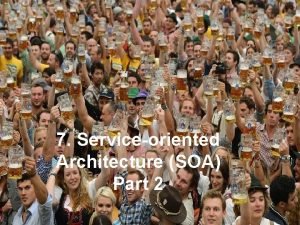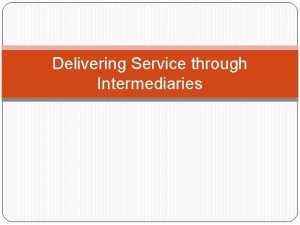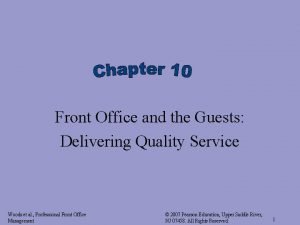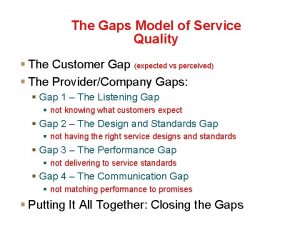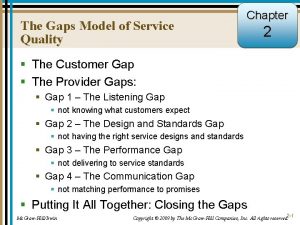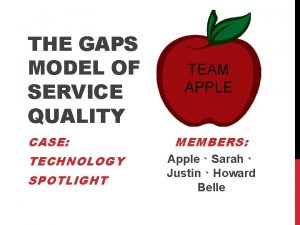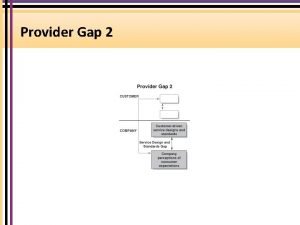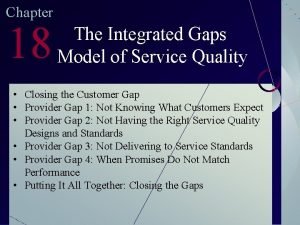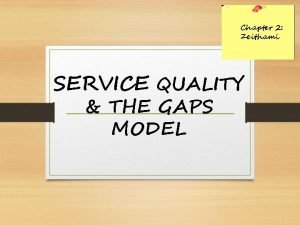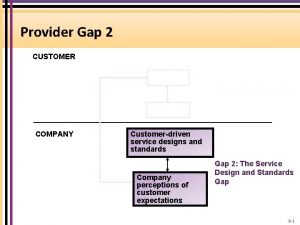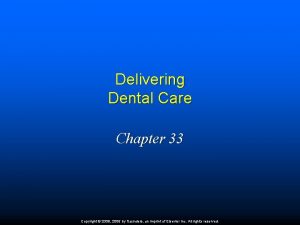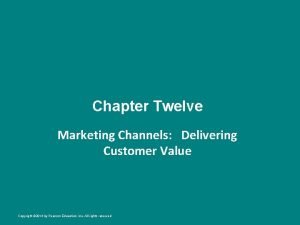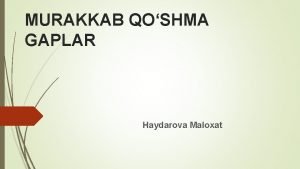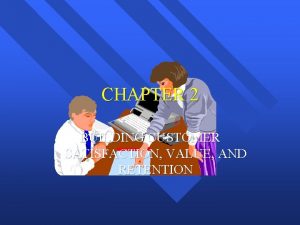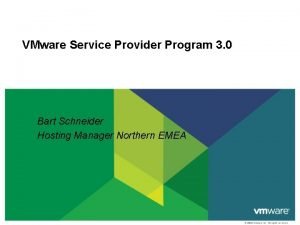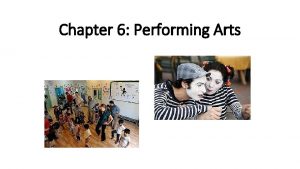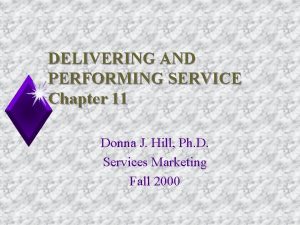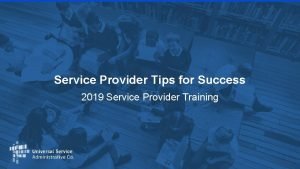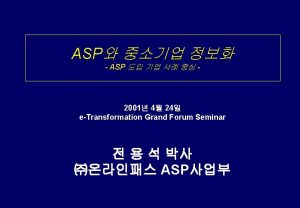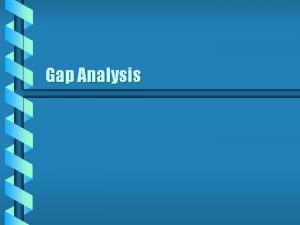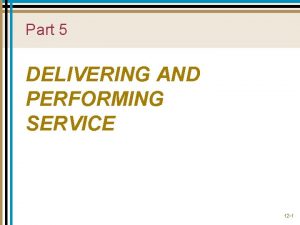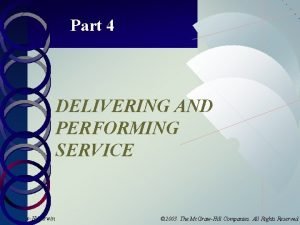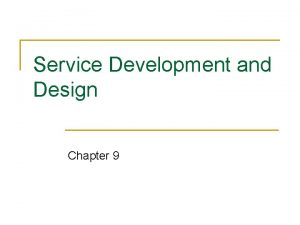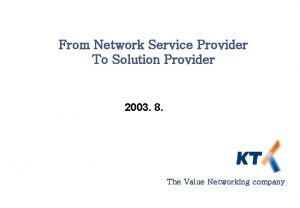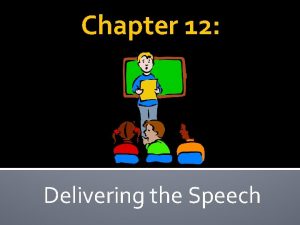Delivering and Performing Service Provider Gap 3 Chapter


















- Slides: 18

Delivering and Performing Service Provider Gap 3 - Chapter 12 CUSTOMER COMPANY Service Delivery Service Performance Gap Customer-Driven Service Designs and Standards Part 5 Opener

Factors Leading to Provider Gap 3 – Poor Service Delivery • Ineffective recruitment of service-oriented employees • Role conflict - _____________ • Poor employee-technology job fit • Lack of empowerment - __________

Service Culture Corporate Culture – the pattern of shared values and beliefs that give the members of an organization meaning, and provide them with the rules for behavior in the organization: ______________ Service Culture – a culture where an appreciation for good service exists, and where giving good service to ____ as well as ultimate, _____ customers is considered a natural way of life and one of the most important norms by everyone; good culture is the _______

Service Culture Flying across the Pacific Ocean is an eight-hour trip that could be dreadful if you did not fly Singapore Airlines. One frequent flyer between the U. S. and Japan noted the Singapore cabin crew do not give the usual impression of doing passengers a favor by taking care of them. Free champagne and beer service is available to all classes. Seating has been designed to provide comfort in the airline's wide body planes. In first class, the seats are referred to as sky suites because they are so roomy. Every meal is carefully planned and served. This commitment is _____________

Service Culture Implications: In many service settings, employees interact with customers with no management present. In such instances, the firm must rely on its service culture to influence employee thoughts, feelings, and behaviors.

Figure 12. 2 The Services Marketing Triangle Company (Management) Internal Marketing External Marketing enabling setting promises Employees Interactive Marketing keeping promises Customers

Ways to Use the Services Marketing Triangle • Overall Strategic Assessment – How is the service organization doing on all three sides of the triangle? – Where are the weaknesses? – What are the strengths? • Specific Service Implementation – What is being promoted and by whom? – How will it be delivered and by whom? – Are the supporting systems in place to deliver the promised service?

The Services Triangle – Types of Marketing Carried Out for Organizational Success External marketing: a firm uses to make promises to customers regarding service delivery “If you enjoyed your meal, please tell a friend” Interactive marketing: service promise being ______ A friendly account executive explains the different types of savings and checking account, as well as other bank services Internal marketing: all the activities a firm must carry out to train, motivate, and reward its ______ to enable the service promise to be delivered

Service profit chain Companies with high levels of ____________ will be more successful than companies that have low levels of employee satisfaction There is a direct relationship between employee satisfaction and customer loyalty

Service Employees Who are they? Service employees (1) embody the service (2) are the product offerings (3) personify the organization in the customer's eyes (4) from a promotional standpoint, service employees are walking billboards for the organization. – “ ” – frontline service employees

Service Employees What are these jobs like? – emotional labor – many sources of _____________ • person/role • organization/client • interclient • quality/productivity

Emotional Labor Emotional labor: delivering smiles, making eye contact, showing sincere interest, and engaging in friendly conversations with customers who are occasionally strangers and who may never be seen again. Disneyworld: ______________

Boundary Spanners Interact with Both Internal and External Constituents (Figure 12. 4) External Environment Internal Environment

Figure 12. 5 Sources of Conflict for Boundary-Spanning Workers • Person vs. Role • Organization vs. Client • Client vs. Client • Quality vs. Productivity

Sources of potential conflict Person/role: conflict between what you are asked to do vs. your own personality, orientation, or values: ___________________ Organization/client: conflict between organization policies and client demands Ex: employees who depend on tips or commissions for income face higher levels of organization/client conflict

Sources of potential conflict Client/client (interclient): incompatible expectations and requirements from two or more customers; __________ Quality/productivity: conflict between effectiveness and efficiency Ex: state auditor is expected to deliver quality, individualized service to state offices and departments, while at the same time finishing jobs as quickly as possible

Closing Gap 3 Hire the right people: • compete for the best people • hire for service competencies and service inclination • be the preferred employer Develop people to deliver the service: • train for technical and interactive skills • empower employees • promote teamwork

Closing Gap 3 Provide needed support systems: • measure internal service quality • provide supportive technology and equipment • develop service-oriented internal processes Retain the best people • include the employees in the company’s vision • treat employees as customers • measure and reward strong service performers
 Evolution of soa
Evolution of soa Hurgusburgus
Hurgusburgus Delivering quality service
Delivering quality service Gaps model of service quality
Gaps model of service quality Gaps model of service quality
Gaps model of service quality The service performance gap
The service performance gap Which of the following factors lead to provider gap 2
Which of the following factors lead to provider gap 2 Provider gap 4
Provider gap 4 Explain the gaps model of service quality.
Explain the gaps model of service quality. Provider gap 2
Provider gap 2 Skills for a high performing civil service
Skills for a high performing civil service Delivering dental care chapter 33
Delivering dental care chapter 33 Chapter 12 marketing channels delivering customer value
Chapter 12 marketing channels delivering customer value Qoʻshma gap turlari
Qoʻshma gap turlari Specification gap is gap between
Specification gap is gap between Developing oral and online presentations
Developing oral and online presentations Customer value satisfaction and retention
Customer value satisfaction and retention Vmware service provider program
Vmware service provider program National verifier service provider portal
National verifier service provider portal
